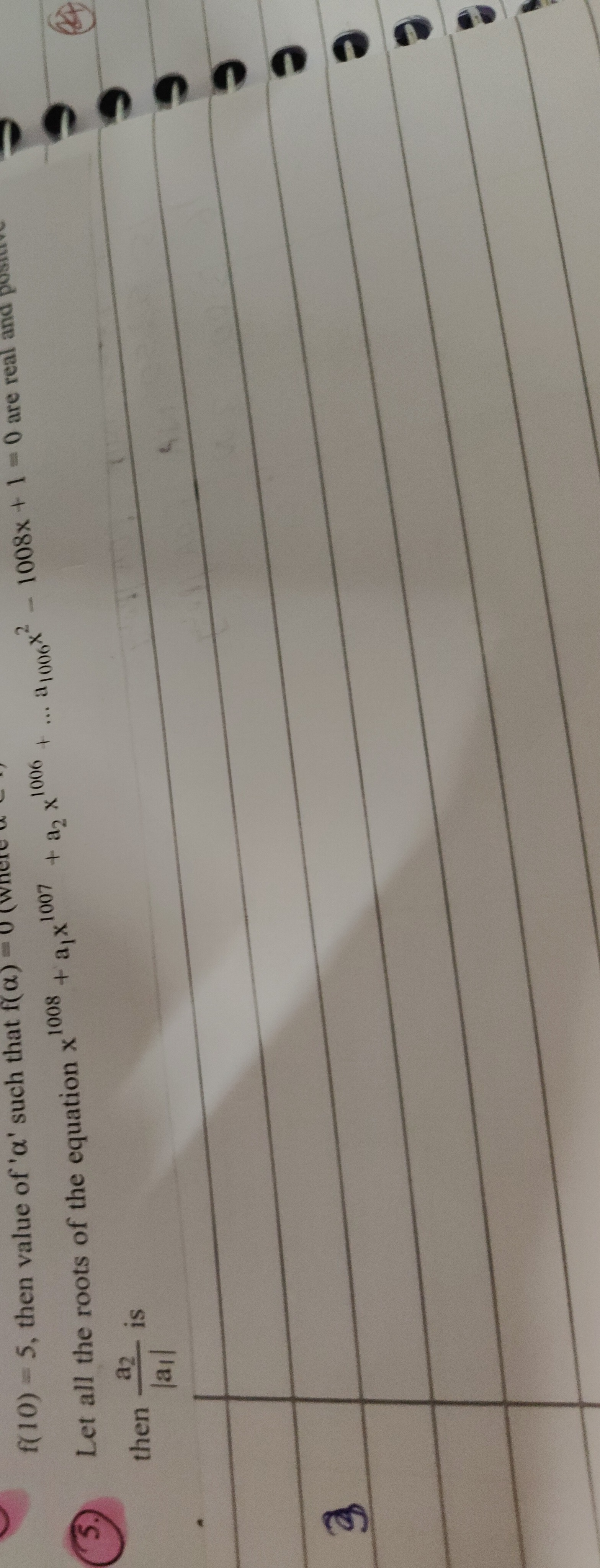Question
Question: f(10) = 5, then value of '$\alpha$' such that f($\alpha$) = 0 (where $\alpha$ > 1). Let all the root...
f(10) = 5, then value of 'α' such that f(α) = 0 (where α > 1). Let all the roots of the equation x1008+a1x1007+a2x1006+...+a1006x2−1008x+1=0 are real and positive
then ∣a1∣a2 is

503.5
Solution
Let the given polynomial be P(x)=x1008+a1x1007+a2x1006+...+a1006x2−1008x+1=0. The degree of the polynomial is n=1008. Let the roots of the equation be r1,r2,...,r1008. We are given that all roots are real and positive.
From Vieta's formulas, for a monic polynomial xn+c1xn−1+c2xn−2+...+cn−1x+cn=0:
- Sum of roots: ∑i=1nri=−c1
- Sum of products of roots taken two at a time: ∑1≤i<j≤nrirj=c2
- Product of roots: ∏i=1nri=(−1)ncn
- Sum of products of roots taken n−1 at a time: ∑k=1nrk∏ri=(−1)n−1cn−1
Comparing the given polynomial with the general form: The coefficient of x1007 is a1. So, c1=a1. The coefficient of x1006 is a2. So, c2=a2. The coefficient of x1 is −1008. So, c1007=−1008. The constant term (coefficient of x0) is 1. So, c1008=1.
Applying Vieta's formulas:
- Sum of roots: ∑i=11008ri=−a1
- Sum of products of roots taken two at a time: ∑1≤i<j≤1008rirj=a2
- Product of roots: ∏i=11008ri=(−1)1008×1=1
- Sum of products of roots taken 1007 at a time: ∑k=11008rk∏ri=(−1)1007(−1008) Since ∏ri=1, this simplifies to ∑k=11008rk1=1008.
Now, we use the AM-GM inequality. For n positive real numbers x1,x2,...,xn, the AM-GM inequality states: nx1+x2+...+xn≥(x1x2...xn)1/n Equality holds if and only if x1=x2=...=xn.
Apply AM-GM to the reciprocals of the roots, 1/r1,1/r2,...,1/r1008: 1008r11+r21+...+r10081≥(r11r21...r10081)1/1008 Substitute the sum of reciprocals and product of roots: 10081008≥(11)1/1008 1≥1
Since the equality holds in the AM-GM inequality, it implies that all the terms must be equal: r11=r21=...=r10081 This means r1=r2=...=r1008. Since their product is ∏ri=1, we must have ri1008=1. As the roots are positive, this implies ri=1 for all i=1,...,1008.
So, all roots of the polynomial are 1. This means the polynomial must be (x−1)1008. We can expand (x−1)1008 using the binomial theorem: (x−1)1008=(01008)x1008(−1)0+(11008)x1007(−1)1+(21008)x1006(−1)2+...+(10071008)x1(−1)1007+(10081008)x0(−1)1008 (x−1)1008=x1008−(11008)x1007+(21008)x1006−...−(11008)x+1
Comparing the coefficients with the given polynomial x1008+a1x1007+a2x1006+...−1008x+1=0:
- Coefficient of x1007: a1=−(11008)=−1008.
- Coefficient of x1006: a2=(21008)=21008×(1008−1)=21008×1007. (We can also verify the coefficient of x: −(10071008)=−(11008)=−1008, which matches the given polynomial).
We need to find the value of ∣a1∣a2. ∣a1∣=∣−1008∣=1008. ∣a1∣a2=100821008×1007=21007=503.5.
The first part of the question "f(10) = 5, then value of 'α' such that f(α) = 0 (where α > 1)." seems unrelated and incomplete. The number '3' at the end is likely the intended answer for the question asked, but based on the provided polynomial and standard mathematical principles, the calculated answer is 503.5. Assuming the problem statement for the polynomial is exactly as written and standard mathematical rules apply, 503.5 is the correct result.
